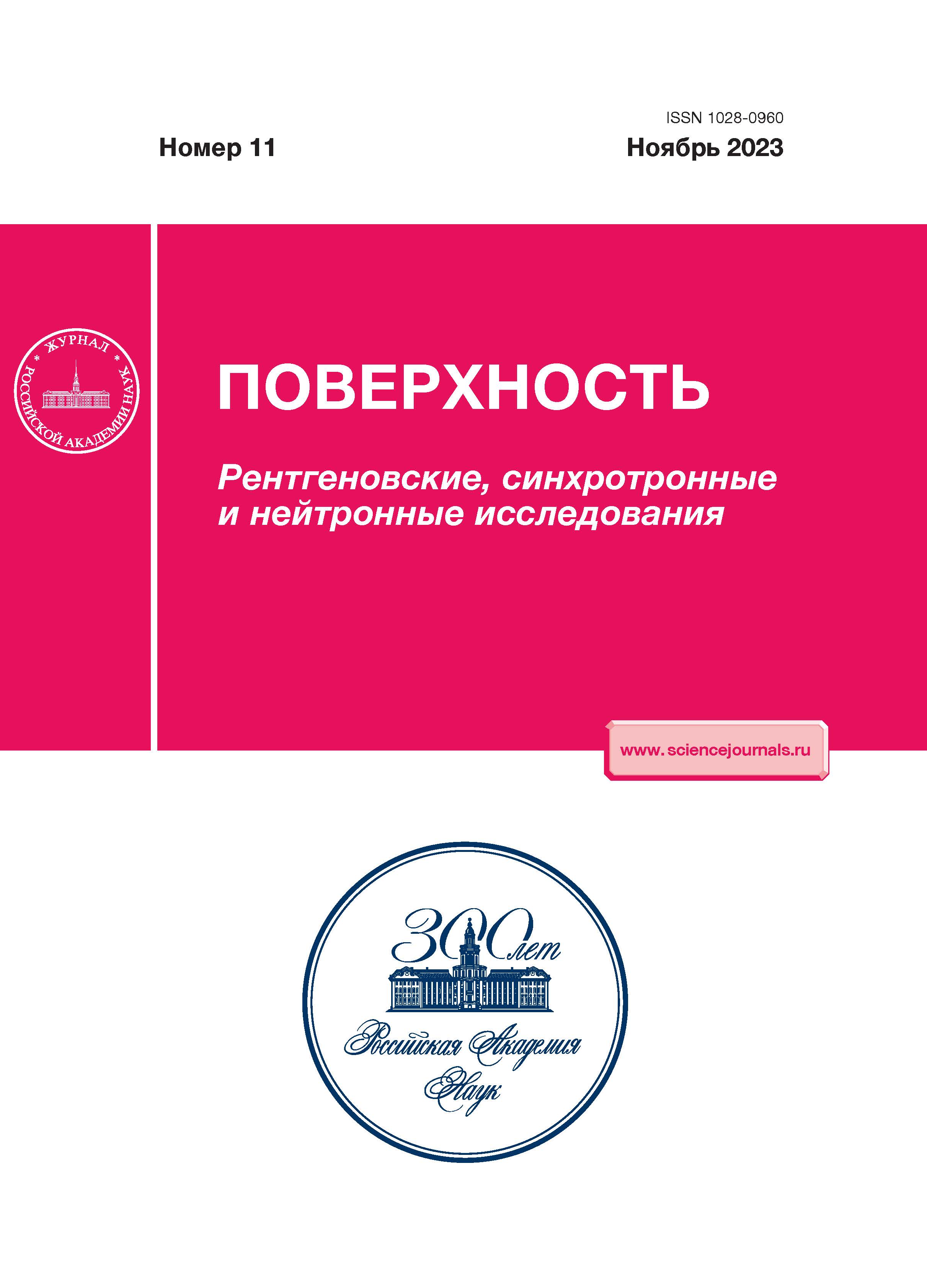Determination of the Thicknesses of Monolayer Coatings Exposed to Ion Bombardment by X-Ray Photoelectron Spectroscopy
- Autores: Afanas’ev V.P.1, Lobanova L.G.1, Selyakov D.N.1, Semenov-Shefov M.A.1
-
Afiliações:
- National Research University “MPEI”
- Edição: Nº 11 (2023)
- Páginas: 53-59
- Seção: Articles
- URL: https://freezetech.ru/1028-0960/article/view/664718
- DOI: https://doi.org/10.31857/S102809602311002X
- EDN: https://elibrary.ru/DSUIPP
- ID: 664718
Citar
Texto integral
Resumo
The samples of monocrystalline silicon coated with golden nanolayers were investigated. The samples were obtained by two methods, namely, gold sputtering using Xe+ beam with the initial energy of 7 keV and the method of thermal deposition. Preliminary analysis of samples based on the deciphering of energy spectra of reflected protons with an initial energy of 25 keV was performed. By methods of X-ray photoelectron spectroscopy with angular resolution (Angle Resolved XPS) thicknesses of gold coatings on silicon were determined. Analysis of samples using X-ray photoelectron spectroscopy was performed by comparing the intensities of Au 4f and Si 2p maxima measured at different angles of photoelectron detection. The calculations carried out by traditional methods indicate a marked dependence of the calculated gold coating thickness on the angle of sight for the case of monolayer and submonolayer coatings. It is shown that such discrepancy is possible if gold is deposited on silicon in the form of clusters forming islands rather than in the form of a continuous homogeneous coating. The possibility of gold islands moving relative to silicon in the upper silicon layers that have been subjected to proton bombardment at sliding angles to the surface is discussed.
Sobre autores
V. Afanas’ev
National Research University “MPEI”
Autor responsável pela correspondência
Email: v.af@mail.ru
Russia, 111250, Moscow
L. Lobanova
National Research University “MPEI”
Email: v.af@mail.ru
Russia, 111250, Moscow
D. Selyakov
National Research University “MPEI”
Email: v.af@mail.ru
Russia, 111250, Moscow
M. Semenov-Shefov
National Research University “MPEI”
Email: v.af@mail.ru
Russia, 111250, Moscow
Bibliografia
- Bulgadaryan D., Sinelnikov D., Kurnaev V., Efimov N., Borisyuk P., Lebedinskii Y. // Nucl. Instrum. Methods Phys. Res. B. 2019. V. 438. P. 54. https://doi.org/10.1016/j.nimb.2018.10.043
- Машкова Е.С., Молчанов В.А. Рассеяние ионов средних энергий поверхностями твердых тел. М.: Атомиздат, 1980. 256 с.
- Курнаев В.А., Машкова Е.С., Молчанов В.А. Отражение легких ионов от поверхности твердого тела. М.: Энергоатомиздат, 1985. 192 с.
- Mashkova E.S., Molchanov V.A. Medium Energy Ion Reflection from Solids. Amsterdam: North-Holland, 1985. 444 p.
- Рязанов М.И., Тилинин И.С. Исследование поверхности по обратному рассеянию частиц. М.: Энергоатомиздат, 1985. 150 с.
- Ziegler J.F., Biersack J.P., Littmark U. The Stopping and Range of Ions in Solids. New York: Pergamon, 1985. 321 p.
- Экштайн В. Компьютерное моделирование взаимодействия частиц с поверхностью твердого тела. М.: Мир, 1995. 319 с.
- Hoffman S. Auger and X-Ray Photoelectron Spectroscopy in Material Science. Berlin: Springer Verlag, 2013. 528 p.
- Steffen J., Hofmann S. // Surf. Interface Anal. 1988. V. 11. P. 617.
- Afanas’ev V.P., Efremenko D.S., Kaplya P.S. // J. Surf. Invest.: X-Ray, Synchrotron Neutron Tech. 2018. V. 12. № 6. P. 1182. https://www.doi.org/10.1134/S1027451018050580
- Afanas’ev V.P., Kaplya P.S. // J. Surf. Invest.: X-Ray, Synchrotron Neutron Tech. 2017. V. 11. № 6. P. 1296. https://www.doi.org/10.1134/S1027451017050226
- Kaplya P.S., Afanas’ev V.P. // J. Surf. Invest.: X-Ray, Synchrotron Neutron Tech. 2017. V. 11. № 5. P. 963. https://www.doi.org/10.1134/S1027451017050056
- Jablonski A. // Surf. Sci. 2019. V. 688. P. 14. https://www.doi.org/10.1016/j.susc.2019.05.004
- Смирнов Б.М. // УФН. 2017. Т. 187. С. 1329. https://www.doi.org/10.3367/UFNe.2017.02.038073
- Trzhaskovskaya M.B., Nefedov V.I., Yarzhemsky V.G. // At. Data Nucl. Data Tables. 2001. V. 77. P. 97. https://www.doi.org/10.1006/adnd.2000.0849
- Trzhaskovskaya M.B., Nefedov V.I., Yarzhemsky V.G. // At. Data Nucl. Data Tables. 2002. V. 82. P. 257. https://www.doi.org/10.1006/adnd.2002.0886
- Tanuma S., Powell C.J., Penn D.R. // Surf. Interface Anal. 2005. V. 37. P. 1. https://www.doi.org/10.1002/sia.1997
- Tougaard S. // J. Vac. Sci. Technol. A. 1996. V. 14. № 3. P. 1415. https://www.doi.org/10.1116/1.579963
- Fairley N., Fernandez V., Richard-Plouet M., Guillot-Deudon C., Walton J., Smith E., Flahaut D., Greiner M., Biesinger M., Tougaard S., Morgan D., Baltrusaitis J. // Appl. Surf. Sci. 2021. V. 5. P. 100112. https://www.doi.org/10.1016/j.apsadv.2021.100112
- Булгадарян Д.Г. Рассеяние протонов кэВ-ных энергий как инструмент анализа тонких слоев на поверхности материалов: Дис. … канд. физ.-мат. наук: 01.04.08. М.: МИФИ, 2020. 116 с.
Arquivos suplementares

















